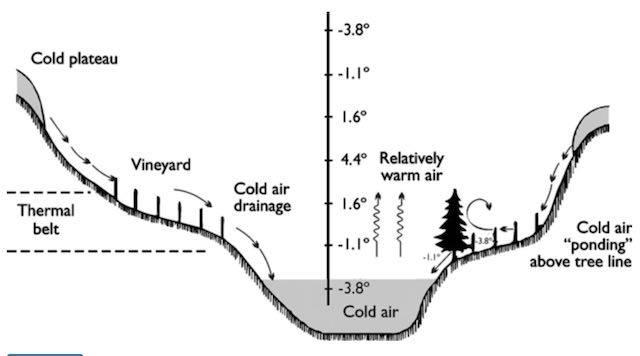Prevention and Management of Frost Injury in Wine Grapes (NC State Extension)

Late-spring frost events can cause severe injury to grapevines, often leading to the loss of fruitful buds and subsequent decreased yield and fruit quality. Severe frost injury has the potential to destroy a whole vintage. In areas such as the Southeast, where spring frosts are common, both passive and active frost control techniques are essential to maintain the longevity and economic sustainability of a vineyard.
However, while active control techniques such as wind machines and sprinkler systems can save a crop during a frost event, implementing those methods is costly and technically challenging. Here we discuss recommended methods of prevention and frost protection, management, and implications of frost injury in grape vines. Please refer to Spring Frost Control, chapter 11 of the North Carolina Winegrape Grower’s Guide for a broader discussion of spring frost control measures.
Introduction
Late spring frosts are common in the southeastern United States, capable of costing several million dollars (Poling, 2008; Zabadal et al., 2007) in damage. In contrast to many other high-value crops, frost protection methods for wine grapes are less frequently deployed, due to high costs and management challenges. However, the damage that can occur as a result of severe frost events can be devastating. Large investments, such as the purchase of wind machines, are economically sustainable if frequent frosts (every five to six years) occur (Poling, 2008). For example, after two frost events in late April and one in mid-May of 2020, more than 70% of North Carolina wine grape vineyards suffered significant crop loss, with some losing close to all fruit for the year. Such losses are devastating if experienced frequently. An integrated approach of preventative measures, management, and pruning can help to mitigate short- and long-term implications of late-spring frost damage.
It is crucial to understand the differences among cold events that can occur in spring. Frost events are caused by radiation, while freeze events are caused by moving air masses that cool surfaces (advection). Generally, cold events can be characterized into three different categories (Table 1): Frost events, frost/freeze events, and freeze events. Frost events are by far the most common during spring in the Southeast, characterized by clear nights and wind speeds less than 5 mph. Hoar frosts are accountable for over 90% of all frost events in the Southeast, often indicated by water crystals forming on surfaces. Another common frost type is black frost that occurs on days with low humidity and therefore the typical ice crystals are missing. Frost generally occurs when the temperature of a surface is equal to or lower than a dew point of 32°F. This is often the case on cloudless, cooler nights that promote radiation (Poling, 2008; Centinari, 2018). Radiation occurs when warmer temperatures during daylight hours heat plants and the soil. Cloud-free skies and cooler temperatures at night cause heat to reradiate from surfaces. Frost then can build up on plant surfaces (shoots, buds, etc.), causing injury through dehydration and physical damage. Clear nights with air temperatures of 40°F or lower, and dew points of 32°F or lower, are at high risk for frost. While the National Weather Service might issue a frost warning at temperatures above 32°F, that does not mean that a radiation frost will occur and damage a specific vineyard.

